Expert techniques for washing, storing, and maintaining cashmere at home while avoiding costly dry cleaning bills
Cashmere clothing brings instant luxury to any wardrobe, but many people worry about caring for these special pieces. The good news is that with proper techniques, you can clean and maintain your cashmere at home without expensive dry cleaning bills or fear of damage. Cool water and gentle detergent specifically made for wool are the safest ways to wash cashmere without causing shrinkage or damage.
This comprehensive guide covers everything from identifying genuine cashmere to troubleshooting common problems. Whether you’re washing your first cashmere sweater or looking to extend the life of treasured pieces, these proven methods will help protect your investment.
Table of Contents
Key Takeaways
- Hand wash cashmere in cool water with wool detergent for best results
- Never wring or twist wet cashmere – press out water gently instead
- Store clean, dry cashmere folded flat in breathable containers
- Regular care actually improves cashmere softness over time
Understanding Cashmere: What Makes It Special
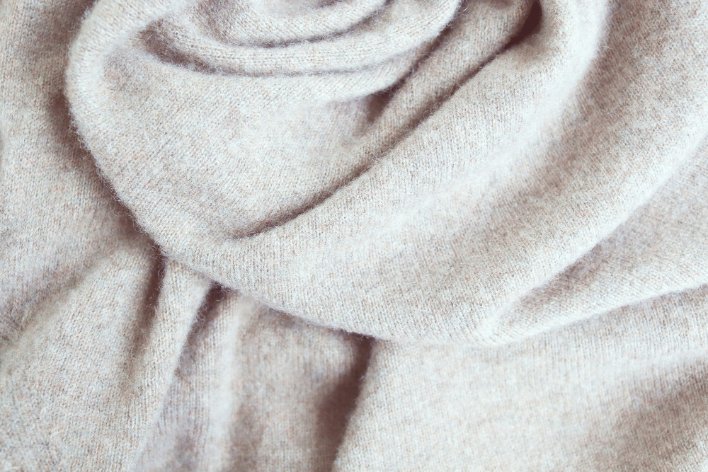
Cashmere is a premium natural fiber that requires special attention to maintain its luxurious quality. This exceptional material comes from the soft undercoat of cashmere goats, primarily found in Mongolia, China, Iran, and the Himalayas.
According to The Good Cashmere Standard, an independent certification body for sustainable cashmere production, quality cashmere is evaluated based on fiber fineness, animal welfare standards, and environmental impact. This organization works directly with herders in Mongolia and other cashmere-producing regions to ensure ethical production practices.
Origins and Quality Factors
Cashmere comes from the fine undercoat that cashmere goats develop as protection against harsh winter temperatures, sometimes reaching -30°F. The goats naturally shed this undercoat each spring, which is then carefully collected and processed.
Quality cashmere is measured by several factors:
- Fiber diameter: Finer fibers (14-15 microns) create softer, more valuable garments
- Fiber length: Longer fibers (28-42mm) are more durable and less prone to pilling
- Color: White cashmere is most valuable as it can be dyed any color
- Ply: Two-ply cashmere is more durable than single-ply
High-quality cashmere is incredibly lightweight yet provides exceptional warmth – about three times warmer than sheep’s wool. The best cashmere feels incredibly soft without any scratchiness.
How to Identify Genuine Cashmere
The Cashmere Goat Association, the leading North American organization for cashmere education and research, states that quality cashmere is evaluated by three primary factors: hair length, thickness (measured in microns), and degree of crimping, all of which directly reflect the animal’s overall health and the resulting fiber quality.
Before learning care techniques, it’s important to verify you have authentic cashmere:
- Touch Test: Genuine cashmere feels incredibly soft but not slippery. It should have a subtle “bite” when rubbed between fingers.
- Burn Test: With a small sample thread, cashmere produces a faint burning hair smell and leaves crushable ash, unlike synthetic fibers that melt.
- Price Check: Quality cashmere is expensive due to limited supply and labor-intensive collection. Suspiciously cheap “cashmere” is likely blended or fake.
- Label Verification: Look for specific cashmere content percentage and country of origin information.
When stretched slightly, good cashmere bounces back to shape. Check for even stitching and minimal pilling, which indicates higher quality fibers.
Want to test your cashmere identification skills? Try our interactive cashmere identification quiz to see how well you can spot authentic cashmere versus fakes.
Basic Cashmere Care Principles
Proper care extends cashmere’s life significantly while maintaining its luxurious feel. These fundamental principles apply to all cashmere garments and form the foundation of effective cashmere care. Following these guidelines prevents most common problems and extends garment life significantly.
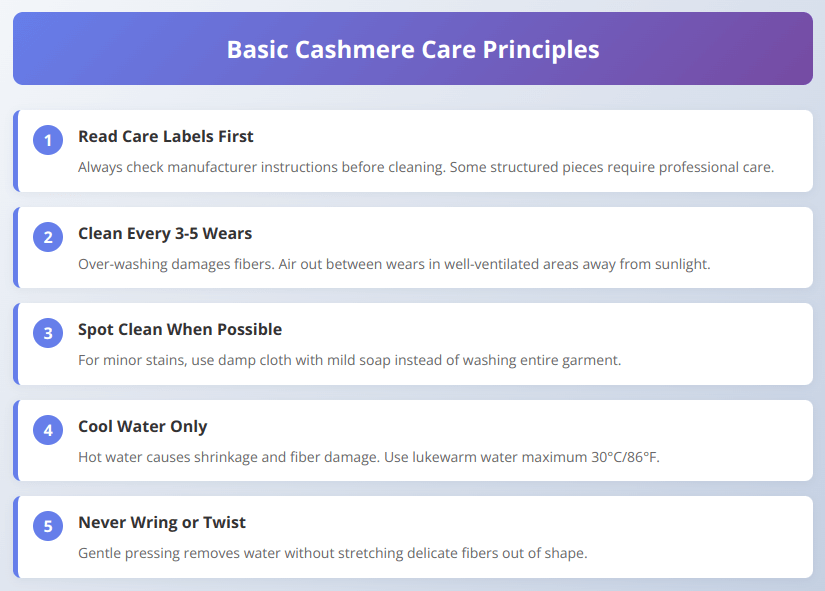
Mastering these basic principles makes the difference between cashmere that lasts decades and pieces that deteriorate quickly.
Not sure how often to clean your specific cashmere pieces? Use our personalized care schedule calculator to get a customized maintenance plan based on your wearing habits.
Understanding Care Labels
Always check the care label on your cashmere garment before cleaning. Most labels recommend dry cleaning, but many cashmere items can be safely hand-washed at home.
Look for specific instructions about water temperature, drying methods, and ironing recommendations. Some manufacturers may void warranties if you don’t follow their care instructions precisely.
Even when labels say “dry clean only,” gentle hand washing is often safe for pure cashmere garments. However, structured pieces with linings or special embellishments should go to professionals.
How Often to Clean Cashmere
Cashmere doesn’t need washing after every wear. Over-washing damages delicate fibers and reduces garment lifespan.
Clean cashmere items every 3-5 wears, or when they show visible soil or develop odors. Between cleanings, air out garments by hanging them in well-ventilated areas away from direct sunlight.
For small spots, try spot cleaning with a damp cloth and mild soap rather than washing the entire piece. This gentle approach preserves fibers while keeping garments fresh.
If you’ve worn cashmere in smoky environments or around strong food odors, air it out overnight before storing.
Hand Washing Cashmere: Step-by-Step Guide
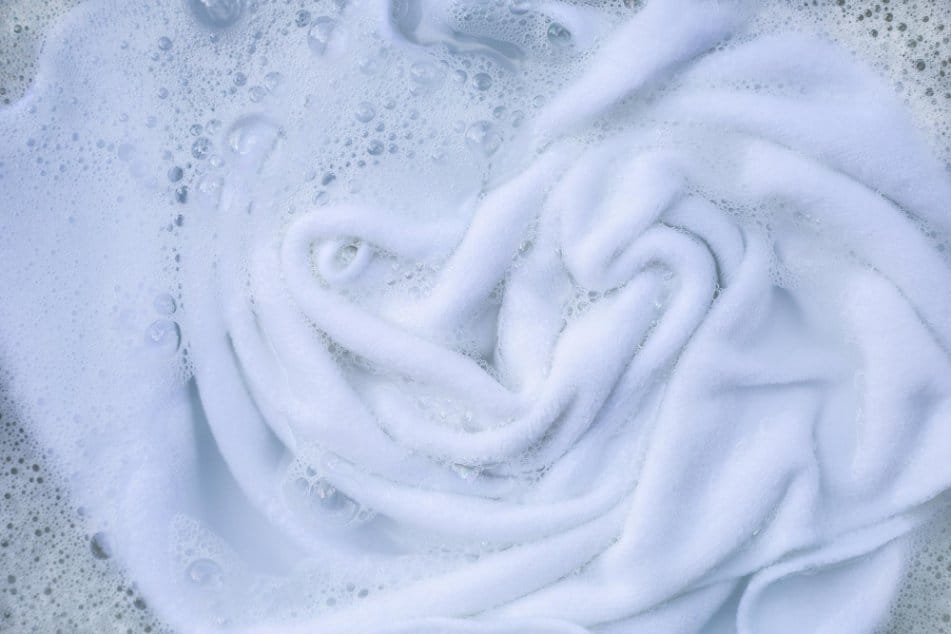
Hand washing is the safest method for cleaning most cashmere garments. This gentle approach preserves fiber integrity while removing soil and odors effectively.
Preparation Steps
Before washing, inspect your garment for stains or spots that need pre-treatment. Turn the item inside out to protect the outer surface during washing. Remove any pills with a cashmere comb or fabric shaver first.
Gather your supplies:
- Clean sink or basin
- Wool detergent or baby shampoo
- Clean white towels
- Flat drying space
Make sure your hands are clean and remove any jewelry that might snag delicate fibers.
Visual Demonstration
Many people find it helpful to see the washing process in action before attempting it themselves. This video demonstrates the key techniques covered in our step-by-step guide:
Note: The techniques shown align with the professional methods outlined below. Pay special attention to the gentle handling and temperature control demonstrated.
This step-by-step process ensures safe, effective hand washing that preserves cashmere’s luxury feel and appearance.
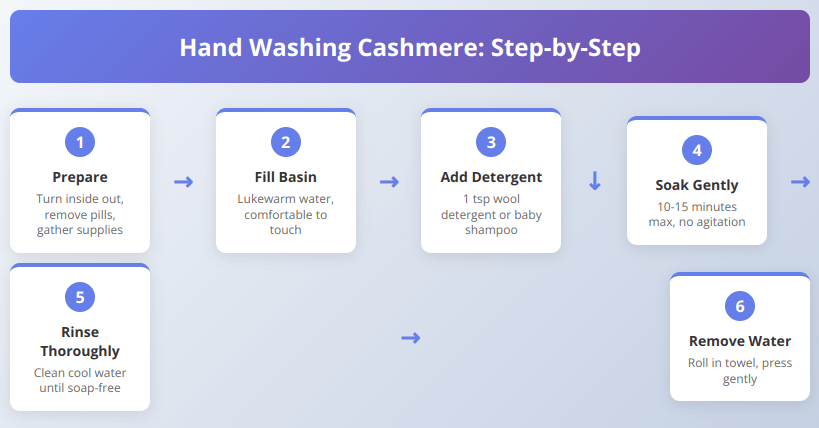
Following this exact sequence protects delicate fibers while achieving thorough cleaning results.
Now let’s walk through each step in detail:
The Washing Process
Step 1: Fill Your Basin Fill a clean sink with lukewarm water – never hot water as it can damage fibers and cause shrinkage. Water should feel comfortable to your hand, similar to a baby’s bath temperature.
Step 2: Add Detergent Add a small amount (about one teaspoon) of wool detergent or baby shampoo. Avoid regular laundry detergents, fabric softeners, or bleach, which can damage cashmere fibers.
Step 3: Soak Gently Gently submerge your cashmere and press it down to allow water to saturate the fabric fully. Never agitate, wring, or twist the garment.
Let it soak for 10-15 minutes maximum. Soaking longer than 30 minutes can weaken fibers.
Step 4: Rinse Thoroughly Drain the soapy water and refill with clean, cool water. Gently press the garment to remove soap, changing rinse water until it runs clear.
Step 5: Remove Excess Water Place the wet cashmere on a clean white towel. Roll the towel with the garment inside like a jelly roll, then press gently to absorb excess water. Never wring or twist.
Detergent Selection Guide
| Best Options | Why They Work | Avoid |
|---|---|---|
| Wool-specific detergents (Eucalan, Woolite) | Gentle cleansers designed for natural fibers | Regular laundry detergent |
| Baby shampoo (unscented) | Mild formula safe for delicate materials | Fabric softeners |
| No-rinse wool wash | Reduces handling and fiber stress | Bleach or whitening agents |
Machine Washing: When and How

While hand washing is preferred, some cashmere can be machine washed with extreme care. Only attempt this with sturdy, unstructured garments.
Pre-Washing Checklist
Before machine washing cashmere:
- Check that your machine has a dedicated wool or hand-wash cycle
- Verify the garment is pure cashmere without special construction
- Turn the garment inside out
- Place it in a mesh laundry bag for protection
Use this guide to determine whether your cashmere is suitable for machine washing and the exact settings required for safe cleaning.
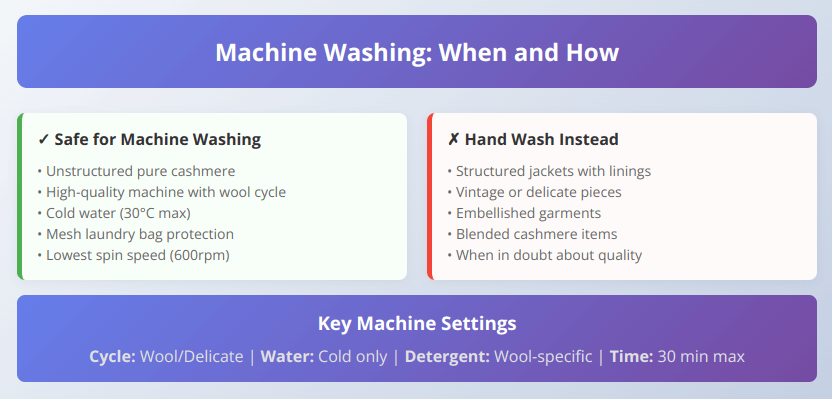
Remember, when in doubt about a garment’s suitability for machine washing, hand washing is always the safer choice.
Machine Settings
Use these specific settings:
- Temperature: Cold water only (30°C/86°F maximum)
- Cycle: Wool, delicate, or hand-wash setting
- Spin: Lowest possible speed (600rpm or less)
- Time: 30 minutes maximum
Add wool detergent and start the cycle. Never use fabric softener, which can coat fibers and reduce natural softness.
Why Hand Washing Is Safer
Machine washing always carries higher risk of damage, even on gentle settings. The agitation and spinning action can stretch fibers or cause felting. Hand washing gives you complete control over pressure and movement.
Drying Cashmere Properly
Proper drying technique is crucial for maintaining cashmere’s shape and preventing permanent damage. This comparison shows correct versus harmful drying methods.

The Flat Drying Method
Never hang wet cashmere – the weight of water stretches fabric permanently. Instead, follow this process:
- Reshape While Damp: Gently manipulate the garment back to its original dimensions
- Choose Your Surface: Use a clean, flat surface covered with a dry towel
- Position Carefully: Lay the garment flat, smoothing out wrinkles
- Ensure Air Circulation: Place away from direct heat, sunlight, or radiators
- Be Patient: Allow 24-48 hours for complete drying
For faster drying, place a second towel on top and roll both towels with the garment inside to absorb more moisture. Then lay flat as described.
Common Drying Mistakes
| Never Do This | Why It’s Harmful | Do This Instead |
|---|---|---|
| Hang to dry | Stretches and distorts shape | Lay flat on towels |
| Use direct heat | Damages fibers, causes shrinkage | Air dry at room temperature |
| Tumble dry | Extreme shrinkage and felting | Patient flat drying |
| Wring out water | Breaks delicate fibers | Gently press with towels |
Managing Pilling and Fabric Care
Pilling – those small balls of fiber on the surface – is normal with cashmere but easily managed with proper techniques.
Pilling management is an essential skill for cashmere owners. This timeline shows the complete process from understanding to prevention.
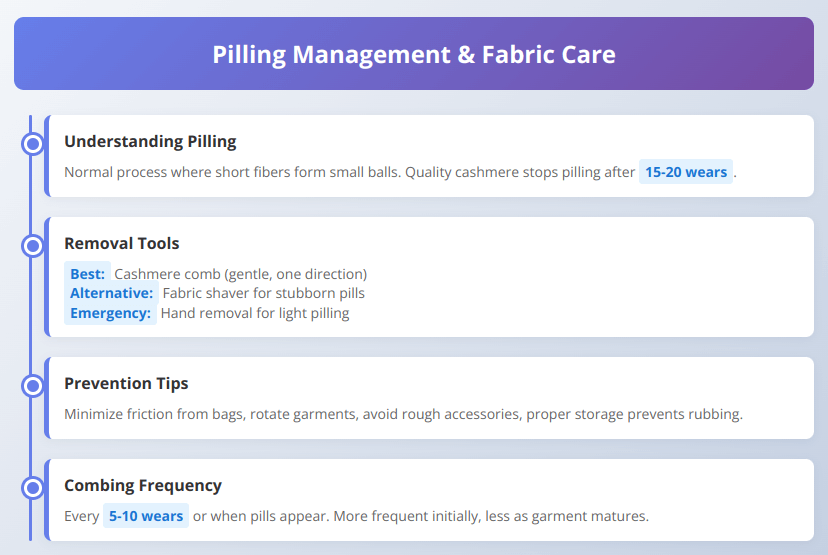
Regular pilling management actually improves cashmere’s appearance and texture over time, making it a beneficial maintenance practice.
Understanding Pilling
Pills form when short fibers twist together in areas of friction during wear. This natural process happens even with expensive cashmere, but high-quality pieces pill less and stop after initial wears.
Pilling occurs most in these areas:
- Under arms and sleeves
- Where bags or straps rub
- Areas that contact other clothing
- Elbows and cuffs
De-Pilling Techniques
Cashmere Comb Method: Use a specialized cashmere comb, working in one direction with light pressure. This is the gentlest option for regular maintenance.
Fabric Shaver Method: For stubborn pills, use a fabric shaver designed for delicates. Hold fabric taut and move the device in small circular motions.
Hand Removal: For occasional pills, gently pluck them off by hand. This works well for light pilling between combing sessions.
Visual De-Pilling Demonstration
Seeing the de-pilling process in action helps you master the technique and avoid common mistakes that can damage cashmere fibers:
This demonstration shows proper tool handling and pressure techniques that work safely on delicate cashmere. Notice how gentle movements achieve effective results without fiber damage.
The key takeaway from this demonstration is the importance of patience and gentle pressure when removing pills.
Prevention Tips:
- Minimize friction by avoiding rough accessories
- Rotate garments to prevent overuse of specific areas
- Store properly to prevent rubbing against other items
How Often to Comb Cashmere
Comb your cashmere after every 5-10 wears, or when you notice pilling. Initial pilling typically stops after the first 15-20 wears if you remove pills promptly.
Regular combing actually improves cashmere’s appearance and softness over time, making it a beneficial maintenance practice rather than just problem-solving.
Storage Solutions and Moth Prevention
Proper storage protects your cashmere investment from damage, pests, and environmental factors. This guide covers both daily and seasonal storage strategies.
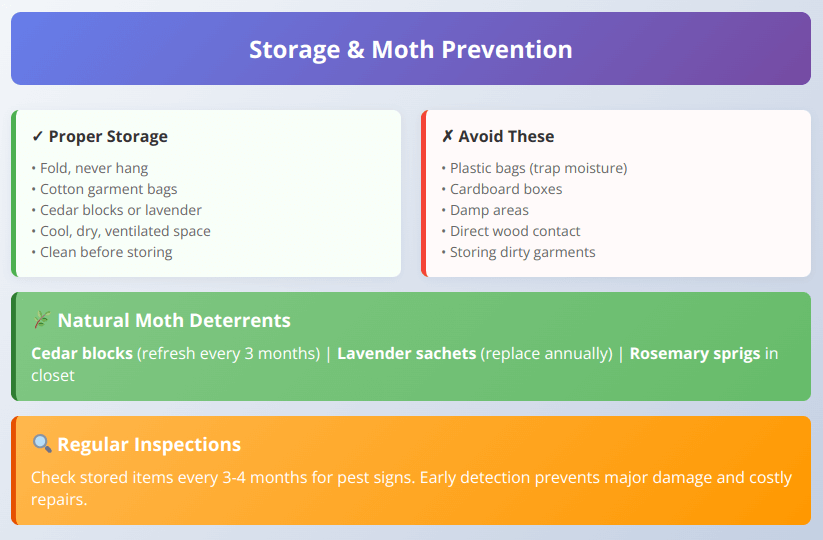
Investing in proper storage materials and following these guidelines protects cashmere for decades while maintaining its luxury quality.
Choosing Storage Materials
Best Options:
- Cotton garment bags (breathable and pest-resistant)
- Acid-free tissue paper for wrapping
- Cedar blocks or lavender sachets
- Well-ventilated drawers or shelves
Avoid These:
- Plastic bags (trap moisture, cause mildew)
- Cardboard boxes (attract insects)
- Damp or poorly ventilated spaces
- Direct contact with wood (can stain)
Folding vs. Hanging
Always fold cashmere for storage. Hanging creates stress points that stretch fibers and distort garment shape permanently.
Proper Folding Technique:
- Lay garment face-down on clean surface
- Fold sleeves toward center back
- Fold in half at waist
- Place acid-free tissue between folds
- Store in breathable container
Comprehensive Moth Prevention
Moths are attracted to natural fibers, especially those with food stains or body oils. Prevention is much easier than dealing with infestations.
Natural Deterrents:
- Cedar blocks (refresh scent every 3 months)
- Lavender sachets (replace annually)
- Rosemary sprigs hung in closets
- Pheromone moth traps for monitoring
Cleaning Before Storage: Always clean cashmere before long-term storage, even if it looks clean. Invisible oils and residues attract pests.
Regular Inspections: Check stored items every 3-4 months for signs of pest activity. Early detection prevents major damage.
Professional Care vs. Home Care
Understanding the cost-benefit analysis of professional versus home care helps you make informed decisions about cashmere maintenance.

Both professional and home care have their place in comprehensive cashmere maintenance, depending on the specific garment and situation.
Wondering about the real cost difference between home care and professional cleaning? Our cost savings calculator shows exactly how much you can save over time with proper home care techniques.
When to Choose Professional Cleaning
Mandatory Professional Care:
- Structured jackets or coats with linings
- Garments with special embellishments
- Items with set-in stains you can’t remove
- Vintage or heirloom pieces
- Heavily soiled garments
Benefits of Professional Service:
- Specialized equipment for deep cleaning
- Experience with luxury fabrics
- Stain removal expertise
- Professional pressing and finishing
Selecting Quality Dry Cleaners
Not all dry cleaners handle cashmere equally well. Ask these questions:
- Do they specialize in luxury fabric care?
- What cleaning solvents do they use for cashmere?
- Do they clean cashmere separately from other items?
- Can they provide references for cashmere cleaning?
Request minimal pressing, as excessive heat can flatten cashmere’s natural texture. Some premium cleaners offer hand-finishing services.
Cost-Benefit Analysis
| Care Method | Cost per Clean | Convenience | Risk Level |
|---|---|---|---|
| Home hand washing | $2-5 | High | Low (with proper technique) |
| Machine washing | $1-3 | Very High | Medium |
| Professional dry cleaning | $15-40 | Medium | Low (good cleaner) |
Troubleshooting Common Problems
When problems arise with cashmere, quick action and proper techniques can often restore garments to their original condition.

Early intervention using these techniques prevents minor issues from becoming permanent damage requiring professional restoration.
Dealing with a specific cashmere problem right now? Get instant solutions with our interactive troubleshooting guide that provides customized fixes based on your exact issue.
Dealing with Shrinkage
Prevention: Always use cool water and avoid agitation, heat, or excessive handling when wet.
If Shrinkage Occurs:
- Soak the garment in lukewarm water with hair conditioner for 10 minutes
- Gently stretch back to original size while damp
- Never pull hard or force stretching
- Reshape and dry flat
For severe shrinkage, professional restoration may be necessary. Some specialized cleaners can restore shrunken cashmere using controlled moisture and stretching techniques.
Stain Removal Strategies
Water-Based Stains (coffee, juice, wine):
- Blot immediately with clean cloth
- Apply cold water with small amount of wool detergent
- Work from outside of stain toward center
- Rinse thoroughly with cold water
Oil-Based Stains (makeup, food oils):
- Sprinkle talcum powder or cornstarch on fresh stains
- Let sit for several hours to absorb oil
- Brush away gently
- Spot-clean with wool detergent if needed
Protein Stains (sweat, food):
- Use enzyme-free detergent (enzymes can damage wool)
- Work in cool water only
- Never use hot water (sets protein stains permanently)
Restoring Softness and Loft
If Cashmere Becomes Stiff:
- Rinse with cool water and small amount of white vinegar
- Use wool conditioner designed for natural fibers
- Ensure complete detergent removal during rinsing
- Steam gently with handheld steamer
If Cashmere Loses Loft:
- Gently brush with soft-bristled brush
- Steam lightly to restore fiber bounce
- Ensure proper storage to prevent compression
Signs Your Cashmere Needs Professional Help
Watch for these indicators:
- Persistent odors after home cleaning
- Stains that don’t respond to gentle treatment
- Significant shrinkage or shape distortion
- Multiple holes from moths or wear
- Loss of color or uneven fading
Advanced Care Tips and Maintenance
Experienced cashmere owners use these advanced techniques to maintain garments for decades while adapting care to different situations.
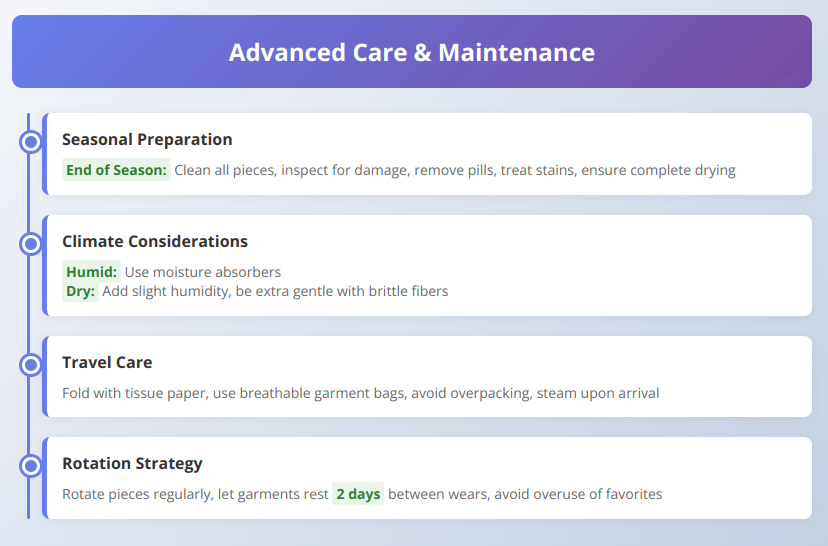
These advanced techniques separate casual cashmere owners from those who maintain garments as treasured, long-term investments.
Seasonal Care Routines
End-of-Season Preparation:
- Clean all pieces before storage
- Inspect for damage requiring repair
- Remove pills and brush gently
- Treat any stains promptly
- Ensure complete drying before storage
Beginning-of-Season Revival:
- Air out stored garments
- Check for pest damage
- Steam lightly to refresh fibers
- Remove any storage odors
Climate Considerations
- Humid Climates: Use moisture absorbers in storage areas and ensure complete drying before storing. Consider cedar products for extra protection.
- Dry Climates: Be extra gentle with fibers, which may be more brittle. Use slight humidity in storage areas if possible.
- Temperature Extremes: Avoid storing cashmere in attics, basements, or other areas with significant temperature fluctuations.
Travel Care
Packing Cashmere:
- Fold with tissue paper
- Pack in breathable garment bags
- Avoid overpacking suitcases
- Steam upon arrival to remove travel wrinkles
Emergency Care While Traveling:
- Spot-clean with hotel amenities if needed
- Use hotel hair conditioner for emergency softening
- Air-dry thoroughly in hotel bathrooms
- Seek local dry cleaner recommendations from hotel concierge
Understanding Cashmere Longevity
Quality cashmere represents excellent value when properly maintained. These statistics demonstrate the true cost-effectiveness of investing in quality pieces.

When calculated per wear, quality cashmere with proper care becomes one of the most economical luxury wardrobe investments.
Factors Affecting Lifespan
- Fiber Quality: Higher-grade cashmere with longer fibers lasts significantly longer than lower grades.
- Construction: Two-ply cashmere is more durable than single-ply. Well-constructed seams and finishing also extend life.
- Care Consistency: Regular, proper care dramatically extends garment life compared to neglect or improper cleaning.
- Wearing Patterns: Rotating pieces and avoiding overuse of individual garments helps maintain their condition.
Maximizing Your Investment
Cost Per Wear Calculation:
- Quality cashmere sweater: $200-500
- Expected wears with proper care: 200-400
- Cost per wear: $1-2.50
Compare this to cheaper alternatives requiring frequent replacement, and quality cashmere becomes economical over time.
When to Retire Cashmere
Even well-cared-for cashmere eventually reaches end of life:
- Multiple holes that affect garment integrity
- Permanent staining or discoloration
- Loss of shape that can’t be restored
- Thinning fabric that’s become transparent
Sustainable Options for Worn Cashmere:
- Professional repairs for small issues
- Repurposing into accessories or craft projects
- Donation to textile recycling programs
- Composting (cashmere is biodegradable)
Cashmere Care Myths Debunked
Separating fact from fiction helps you make better care decisions and avoid damaging your cashmere based on common misconceptions.

Understanding these facts empowers you to care for cashmere confidently while ignoring well-meaning but incorrect advice.
Common Misconceptions
Myth: “Cashmere gets ruined if it gets wet”
Reality: Cashmere can be safely washed in water with proper technique. It’s made from animal hair, which naturally encounters moisture.
Myth: “You should put cashmere in the freezer to kill moths”
Reality: Freezing doesn’t reliably kill all moth eggs and larvae. Proper cleaning and storage prevention are more effective.
Myth: “Expensive cashmere never pills”
Reality: All cashmere pills initially due to short fibers working their way to the surface. Quality cashmere stops pilling sooner and pills less overall.
Myth: “Fabric softener makes cashmere softer”
Reality: Fabric softener coats fibers and actually reduces cashmere’s natural softness over time.
Scientific Facts About Cashmere
- Cashmere fibers are hollow, providing excellent insulation
- The natural crimp in cashmere fibers creates loft and warmth
- Cashmere is naturally antibacterial, requiring less frequent washing
- Quality cashmere becomes softer with proper care over time
Comprehensive FAQ Section
General Care Questions
How do you maintain cashmere?
Maintain cashmere through gentle hand washing every 3-5 wears, proper flat drying, regular de-pilling, and careful storage in breathable containers with moth deterrents.
What should you not do with cashmere?
Never wring, twist, or hang wet cashmere. Avoid hot water, regular detergent, fabric softener, tumble drying, or storing in plastic bags.
How do you care for 100% cashmere?
Pure cashmere requires the gentlest care: hand wash in cool water with wool detergent, press out water with towels, dry flat, and store folded with cedar or lavender.
Can 100% cashmere be washed?
Yes, 100% cashmere can be safely hand-washed at home using cool water and appropriate wool detergent. Many care labels are overly cautious.
Restoration and Repair
How to bring cashmere back to life?
Revive tired cashmere by gentle hand washing with wool detergent, thorough rinsing, careful drying, and light steaming to restore loft.
How to make cashmere fluffy again?
Restore fluffiness by washing gently, ensuring complete detergent removal, drying flat, and lightly brushing with a soft-bristled brush or steaming.
How to unshrink 100% cashmere?
Soak shrunken cashmere in lukewarm water with hair conditioner for 10 minutes, then gently stretch back to size while damp. Results vary depending on shrinkage severity.
Technical Questions
Why can’t cashmere get wet?
This is a myth. Cashmere can get wet safely. The concern is about hot water and rough handling when wet, which can cause shrinkage and fiber damage.
Can you overheat cashmere?
Yes, excessive heat from hot water, direct sunlight, radiators, or high-temperature pressing can damage fibers, cause shrinkage, and reduce softness.
Why shouldn’t you hang cashmere?
Hanging stretches the knit structure, especially when wet. The garment’s weight pulls fibers out of shape permanently, creating distortion that’s difficult to reverse.
Maintenance Frequency
How often should you comb cashmere?
Comb cashmere every 5-10 wears or when you notice pilling. During the first 20 wears, you may need to comb more frequently as initial short fibers work to the surface.
How many times can you wear cashmere before washing?
Wear cashmere 3-5 times before washing, depending on activity level and exposure to odors. Cashmere’s natural antibacterial properties reduce washing frequency needs.
When to stop wearing cashmere?
Stop wearing specific pieces when they develop holes affecting structural integrity, permanent stains, or severe shape distortion. Well-cared-for cashmere can last 10-15 years.
Storage and Seasonal Care
How do you keep cashmere in good condition?
Maintain cashmere through proper washing, complete drying, regular de-pilling, folded storage with moth deterrents, and seasonal cleaning before storage.
How to keep cashmere looking new?
Keep cashmere looking new by washing infrequently but properly, removing pills promptly, storing correctly, rotating pieces to prevent overuse, and addressing stains immediately.
How long does 100% cashmere last?
Quality 100% cashmere lasts 10-15 years with proper care, often becoming softer and more beautiful with age when maintained correctly.
Special Situations
What to do with worn out cashmere?
Repurpose worn cashmere into accessories, donate to textile recycling, compost (it’s biodegradable), or have professional repairs done for valuable pieces.
How do you know if cashmere is ruined?
Cashmere is likely ruined if it has multiple large holes, severe permanent shrinkage, irreversible shape distortion, or felting that makes it stiff and unwearable.
Should I use fabric conditioner on cashmere?
No, never use fabric conditioner on cashmere. It coats fibers and reduces natural softness. Use wool-specific conditioners only if needed for restoration.
The Environmental and Economic Benefits
Proper cashmere care supports both environmental sustainability and personal economics, making it a responsible choice for conscious consumers.
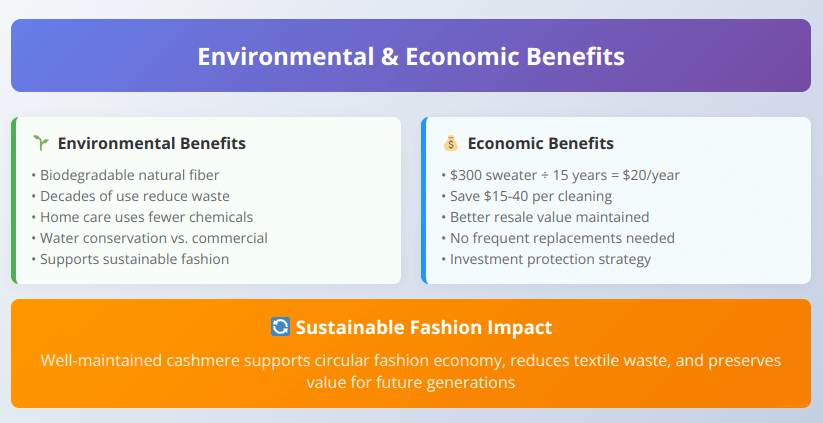
These benefits make cashmere care not just about luxury maintenance, but about supporting sustainable, economical fashion choices.
Environmental Impact
- Longevity Benefits: Well-maintained cashmere lasts decades, reducing textile waste and the environmental cost of frequent replacements.
- Natural Biodegradability: Unlike synthetic alternatives, cashmere eventually decomposes naturally when it reaches end of life.
- Reduced Chemical Usage: Home care typically uses fewer harsh chemicals than commercial dry cleaning processes.
- Water Conservation: Hand washing uses significantly less water than machine washing or commercial cleaning processes.
Economic Value Protection
- Investment Preservation: A $300 cashmere sweater maintained for 15 years costs $20 per year, compared to replacing cheaper alternatives annually.
- Reduced Professional Cleaning Costs: Home care saves $15-40 per cleaning while often providing gentler treatment.
- Resale Value: Well-maintained cashmere retains value better than poorly cared for pieces, supporting sustainable fashion practices.
Conclusion
Caring for cashmere at home is both achievable and rewarding when you understand the proper techniques. This comprehensive guide provides everything needed to maintain your cashmere investment for years while saving money on professional cleaning.
Key Success Factors
The most important elements for cashmere care success are gentleness, patience, and consistency. Cool water, mild detergent, gentle handling, and proper storage form the foundation of effective home care. Regular maintenance through de-pilling and proper storage prevents most problems before they occur.
Quality cashmere actually improves with proper care, becoming softer and more beautiful over time. This makes the initial investment in learning correct techniques worthwhile for both immediate garment care and long-term wardrobe management.
Essential Takeaways
- For New Cashmere Owners: Start with hand washing using wool detergent and cool water. Never rush the process – gentle, patient care prevents damage and maintains quality.
- For Experienced Owners: Implement seasonal care routines, invest in proper storage materials, and address any care mistakes promptly to prevent permanent damage.
- For Budget-Conscious Consumers: Home care saves significant money over professional cleaning while often providing gentler treatment. The techniques in this guide can save hundreds of dollars annually for cashmere enthusiasts.
Long-Term Care Strategy
Develop a routine that includes regular wearing rotation, prompt stain treatment, seasonal deep cleaning, and proper storage. This systematic approach maximizes garment lifespan while minimizing care effort and cost.
Consider cashmere care an investment in both your wardrobe and personal style. Well-maintained pieces become more valuable over time, both economically and sentimentally, often becoming treasured items passed between generations.
Remember that small efforts in daily care prevent major problems later. Air garments between wears, address pills promptly, store properly, and clean gently but thoroughly when needed.
With these techniques, your cashmere collection will provide decades of luxury, comfort, and style while maintaining its value and beauty. The time invested in learning proper care pays dividends in garment longevity, appearance, and personal satisfaction with your wardrobe investment.

